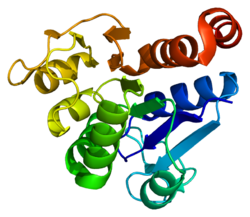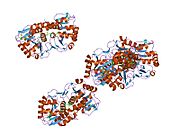파크7
PARK7Diglycase DJ-1은 인간에게 PARK7 유전자에 의해 암호화된 단백질이다.[5]
구조
유전자
DJ-1로도 알려진 유전자 PARK7은 펩티다아제 C56 계열의 단백질을 인코딩한다. 인간 유전자 PARK7은 8개의 엑손들을 가지고 있으며 염색체 대역 1p36.23에 위치한다.[5]
단백질
인간 단백질인 디글리케이스 DJ-1은 크기가 20kDa이며, 총 7개의 β-스트란드와 9개의 α-헬리크로 구성된 189개의 아미노산으로 구성되어 있으며, 디머로 존재한다.[6][7][8] 펩티다아제 C56 단백질군에 속한다.
인간 단백질인 DJ-1, 대장균 샤페론 Hsp31, YhbO, YajL의 단백질 구조와 고고학적 단백질이 진화적으로 보존되어 있다.[9]
함수
산화 조건 하에서 단백질 디글리케이스 DJ-1은 샤페론 활동을 통해 α-시뉴클레인의 집적을 억제하여 리독스 민감 샤페론 및 산화 응력의 센서로서 기능한다.[10][11] 이에 따라 DJ-1은 산화스트레스와 세포사멸로부터 뉴런을 보호하는 것으로 보인다.[5] 이와 병행하여 단백질 DJ-1은 안드로겐 수용체 의존적 전사의 양성 조절기 역할을 한다. DJ-1은 포유류의 신경망막과 망막색소 상피에서 모두 발현되며, 생리학적 및 병리학적 조건 모두에서 산화적 스트레스에 대해 신경보호적 역할을 수행한다.[12][13]
PQQ(Pyrloquinoline Quinone)는 파킨슨병의 초기 단계인 DJ-1 단백질의 자가산화를 감소시키는 것으로 나타났다.[14]
기능성 DJ-1 단백질이 금속을 결합하고 금속으로 유도되는 세포독성으로부터 구리와 수은으로부터 보호하는 것으로 나타났다.[15]
임상적 유의성
이 유전자의 결함은 자가 열성 조기전염 파킨슨병 7의 원인이다.[5][16]
상호작용
PARK7은 다음과 상호 작용하는 것으로 나타났다.
참고 항목
참조
- ^ a b c GRCh38: 앙상블 릴리스 89: ENSG00000116288 - 앙상블, 2017년 5월
- ^ a b c GRCm38: 앙상블 릴리스 89: ENSMUSG000028964 - 앙상블, 2017년 5월
- ^ "Human PubMed Reference:". National Center for Biotechnology Information, U.S. National Library of Medicine.
- ^ "Mouse PubMed Reference:". National Center for Biotechnology Information, U.S. National Library of Medicine.
- ^ a b c d "Entrez Gene: PARK7".
- ^ "Uniprot: Q99497 - PARK7_HUMAN".
- ^ Honbou K, Suzuki NN, Horiuchi M, Niki T, Taira T, Ariga H, Inagaki F (Aug 2003). "The crystal structure of DJ-1, a protein related to male fertility and Parkinson's disease". The Journal of Biological Chemistry. 278 (33): 31380–4. doi:10.1074/jbc.M305878200. PMID 12796482.
- ^ Tao X, Tong L (Aug 2003). "Crystal structure of human DJ-1, a protein associated with early onset Parkinson's disease". The Journal of Biological Chemistry. 278 (33): 31372–9. doi:10.1074/jbc.M304221200. PMID 12761214.
- ^ Lee SJ, Kim SJ, Kim IK, Ko J, Jeong CS, Kim GH, Park C, Kang SO, Suh PG, Lee HS, Cha SS (Nov 2003). "Crystal structures of human DJ-1 and Escherichia coli Hsp31, which share an evolutionarily conserved domain". The Journal of Biological Chemistry. 278 (45): 44552–9. doi:10.1074/jbc.M304517200. PMID 12939276.
- ^ Shendelman S, Jonason A, Martinat C, Leete T, Abeliovich A (Nov 2004). "DJ-1 is a redox-dependent molecular chaperone that inhibits alpha-synuclein aggregate formation". PLOS Biology. 2 (11): e362. doi:10.1371/journal.pbio.0020362. PMC 521177. PMID 15502874.
- ^ Zhou W, Zhu M, Wilson MA, Petsko GA, Fink AL (Mar 2006). "The oxidation state of DJ-1 regulates its chaperone activity toward alpha-synuclein". Journal of Molecular Biology. 356 (4): 1036–48. doi:10.1016/j.jmb.2005.12.030. PMID 16403519.
- ^ Martín-Nieto, José; Uribe, Mary Luz; Esteve-Rudd, Julián; Herrero, María Trinidad; Campello, Laura (2019). "A role for DJ-1 against oxidative stress in the mammalian retina". Neuroscience Letters. 708: 134361. doi:10.1016/j.neulet.2019.134361. hdl:10045/94474. PMID 31276729. S2CID 195813073.
- ^ Shadrach, Karen G.; Rayborn, Mary E.; Hollyfield, Joe G.; Bonilha, Vera L. (2013). Shi, Xianglin (ed.). "DJ-1-Dependent Regulation of Oxidative Stress in the Retinal Pigment Epithelium (RPE)". PLOS ONE. 8 (7): e67983. Bibcode:2013PLoSO...867983S. doi:10.1371/journal.pone.0067983. PMC 3699467. PMID 23844142.
- ^ Nunome K, Miyazaki S, Nakano M, Iguchi-Ariga S, Ariga H (Jul 2008). "Pyrroloquinoline quinone prevents oxidative stress-induced neuronal death probably through changes in oxidative status of DJ-1". Biological & Pharmaceutical Bulletin. 31 (7): 1321–6. doi:10.1248/bpb.31.1321. hdl:2115/53726. PMID 18591768.
- ^ Björkblom B, Adilbayeva A, Maple-Grødem J, Piston D, Ökvist M, Xu XM, Brede C, Larsen JP, Møller SG (2013). "Parkinson disease protein DJ-1 binds metals and protects against metal-induced cytotoxicity". Journal of Biological Chemistry. 288 (31): 22809–20. doi:10.1074/jbc.M113.482091. PMC 3829365. PMID 23792957.
- ^ Bonifati V, Rizzu P, van Baren MJ, Schaap O, Breedveld GJ, Krieger E, Dekker MC, Squitieri F, Ibanez P, Joosse M, van Dongen JW, Vanacore N, van Swieten JC, Brice A, Meco G, van Duijn CM, Oostra BA, Heutink P (Jan 2003). "Mutations in the DJ-1 gene associated with autosomal recessive early-onset parkinsonism". Science. 299 (5604): 256–9. Bibcode:2003Sci...299..256B. doi:10.1126/science.1077209. PMID 12446870. S2CID 27186691.
- ^ Mukherjee K, Slawson JB, Christmann BL, Griffith LC (2014). "Neuron-specific protein interactions of Drosophila CASK-β are revealed by mass spectrometry". Frontiers in Molecular Neuroscience. 7: 58. doi:10.3389/fnmol.2014.00058. PMC 4075472. PMID 25071438.
- ^ Niki T, Takahashi-Niki K, Taira T, Iguchi-Ariga SM, Ariga H (Feb 2003). "DJBP: a novel DJ-1-binding protein, negatively regulates the androgen receptor by recruiting histone deacetylase complex, and DJ-1 antagonizes this inhibition by abrogation of this complex". Molecular Cancer Research. 1 (4): 247–61. PMID 12612053.
- ^ Takahashi K, Taira T, Niki T, Seino C, Iguchi-Ariga SM, Ariga H (Oct 2001). "DJ-1 positively regulates the androgen receptor by impairing the binding of PIASx alpha to the receptor". The Journal of Biological Chemistry. 276 (40): 37556–63. doi:10.1074/jbc.M101730200. PMID 11477070.
추가 읽기
- Cookson MR (Jan 2003). "Pathways to Parkinsonism". Neuron. 37 (1): 7–10. doi:10.1016/S0896-6273(02)01166-2. PMID 12526767. S2CID 14513509.
- Bonifati V, Oostra BA, Heutink P (Mar 2004). "Linking DJ-1 to neurodegeneration offers novel insights for understanding the pathogenesis of Parkinson's disease". Journal of Molecular Medicine. 82 (3): 163–74. doi:10.1007/s00109-003-0512-1. PMID 14712351. S2CID 32685319.
- Le W, Appel SH (Feb 2004). "Mutant genes responsible for Parkinson's disease". Current Opinion in Pharmacology. 4 (1): 79–84. doi:10.1016/j.coph.2003.09.005. PMID 15018843.
- Abou-Sleiman PM, Healy DG, Wood NW (Oct 2004). "Causes of Parkinson's disease: genetics of DJ-1". Cell and Tissue Research. 318 (1): 185–8. doi:10.1007/s00441-004-0922-6. PMID 15503154. S2CID 9453283.
- Pankratz N, Foroud T (Apr 2004). "Genetics of Parkinson disease". NeuroRx. 1 (2): 235–42. doi:10.1602/neurorx.1.2.235. PMC 534935. PMID 15717024.
- Heutink P (2006). "PINK-1 and DJ-1--new genes for autosomal recessive Parkinson's disease". Journal of Neural Transmission. Supplementum. Journal of Neural Transmission. Supplementa. 70 (70): 215–9. doi:10.1007/978-3-211-45295-0_33. ISBN 978-3-211-28927-3. PMID 17017532.
- Lev N, Roncevic D, Roncevich D, Ickowicz D, Melamed E, Offen D (2007). "Role of DJ-1 in Parkinson's disease". Journal of Molecular Neuroscience. 29 (3): 215–25. doi:10.1385/JMN:29:3:215. PMID 17085780. S2CID 85481215.
- Nagakubo D, Taira T, Kitaura H, Ikeda M, Tamai K, Iguchi-Ariga SM, Ariga H (Feb 1997). "DJ-1, a novel oncogene which transforms mouse NIH3T3 cells in cooperation with ras". Biochemical and Biophysical Research Communications. 231 (2): 509–13. doi:10.1006/bbrc.1997.6132. PMID 9070310.
- Taira T, Takahashi K, Kitagawa R, Iguchi-Ariga SM, Ariga H (Jan 2001). "Molecular cloning of human and mouse DJ-1 genes and identification of Sp1-dependent activation of the human DJ-1 promoter". Gene. 263 (1–2): 285–92. doi:10.1016/S0378-1119(00)00590-4. PMID 11223268.
- van Duijn CM, Dekker MC, Bonifati V, Galjaard RJ, Houwing-Duistermaat JJ, Snijders PJ, Testers L, Breedveld GJ, Horstink M, Sandkuijl LA, van Swieten JC, Oostra BA, Heutink P (Sep 2001). "Park7, a novel locus for autosomal recessive early-onset parkinsonism, on chromosome 1p36". American Journal of Human Genetics. 69 (3): 629–34. doi:10.1086/322996. PMC 1235491. PMID 11462174.
- Takahashi K, Taira T, Niki T, Seino C, Iguchi-Ariga SM, Ariga H (Oct 2001). "DJ-1 positively regulates the androgen receptor by impairing the binding of PIASx alpha to the receptor". The Journal of Biological Chemistry. 276 (40): 37556–63. doi:10.1074/jbc.M101730200. PMID 11477070.
- Bonifati V, Rizzu P, van Baren MJ, Schaap O, Breedveld GJ, Krieger E, Dekker MC, Squitieri F, Ibanez P, Joosse M, van Dongen JW, Vanacore N, van Swieten JC, Brice A, Meco G, van Duijn CM, Oostra BA, Heutink P (Jan 2003). "Mutations in the DJ-1 gene associated with autosomal recessive early-onset parkinsonism". Science. 299 (5604): 256–9. Bibcode:2003Sci...299..256B. doi:10.1126/science.1077209. PMID 12446870. S2CID 27186691.
- Bonifati V, Dekker MC, Vanacore N, Fabbrini G, Squitieri F, Marconi R, Antonini A, Brustenghi P, Dalla Libera A, De Mari M, Stocchi F, Montagna P, Gallai V, Rizzu P, van Swieten JC, Oostra B, van Duijn CM, Meco G, Heutink P (Sep 2002). "Autosomal recessive early onset parkinsonism is linked to three loci: PARK2, PARK6, and PARK7". Neurological Sciences. 23 Suppl 2: S59-60. doi:10.1007/s100720200069. PMID 12548343. S2CID 13625056.
- Niki T, Takahashi-Niki K, Taira T, Iguchi-Ariga SM, Ariga H (Feb 2003). "DJBP: a novel DJ-1-binding protein, negatively regulates the androgen receptor by recruiting histone deacetylase complex, and DJ-1 antagonizes this inhibition by abrogation of this complex". Molecular Cancer Research. 1 (4): 247–61. PMID 12612053.
- Tao X, Tong L (Aug 2003). "Crystal structure of human DJ-1, a protein associated with early onset Parkinson's disease". The Journal of Biological Chemistry. 278 (33): 31372–9. doi:10.1074/jbc.M304221200. PMID 12761214.
- Honbou K, Suzuki NN, Horiuchi M, Niki T, Taira T, Ariga H, Inagaki F (Aug 2003). "The crystal structure of DJ-1, a protein related to male fertility and Parkinson's disease". The Journal of Biological Chemistry. 278 (33): 31380–4. doi:10.1074/jbc.M305878200. PMID 12796482.
- Dekker M, Bonifati V, van Swieten J, Leenders N, Galjaard RJ, Snijders P, Horstink M, Heutink P, Oostra B, van Duijn C (Jul 2003). "Clinical features and neuroimaging of PARK7-linked parkinsonism". Movement Disorders. 18 (7): 751–7. doi:10.1002/mds.10422. PMID 12815653. S2CID 44253517.
- Miller DW, Ahmad R, Hague S, Baptista MJ, Canet-Aviles R, McLendon C, Carter DM, Zhu PP, Stadler J, Chandran J, Klinefelter GR, Blackstone C, Cookson MR (Sep 2003). "L166P mutant DJ-1, causative for recessive Parkinson's disease, is degraded through the ubiquitin-proteasome system". The Journal of Biological Chemistry. 278 (38): 36588–95. doi:10.1074/jbc.M304272200. PMID 12851414.
외부 링크
이 기사는 공공영역에 있는 미국 국립 의학 도서관의 텍스트를 통합하고 있다.

















